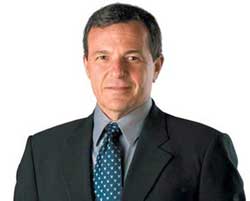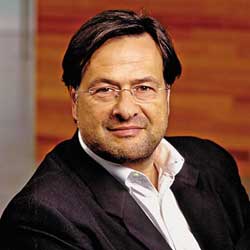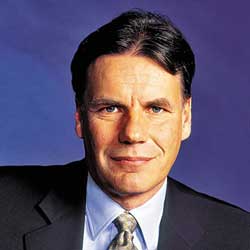Behind the success of every corporation, there is often the shadow of at least one “key person.” Their decisions and strategies can sometimes change the entire machinery of the global tech world. This is a portrait of the most talented leaders in the technology sector, as voted by BusinessWeek Online (Part II).
The Best Minds in IT 2005 (Part I) 7. Marissa Mayer – The “Beautiful Woman” Behind Google
7. Marissa Mayer – The “Beautiful Woman” Behind Google
The management style at Google is always unconventional. Officials are extremely reticent in guiding their subordinates. Engineers are free to pursue the projects that excite them the most. This is the mantra of Google: Every idea that comes from the engineers’ minds is nurtured to become a successful product.
In this “loose but tight” management approach, Marissa Mayer is the most seasoned. The Vice President in charge of Google’s search products often meets with employees outside of the office, in cafes or fast-food restaurants, rather than within four office walls. She also frequently goes “hunting” for promising ideas by organizing three “open meetings” each week.
At just 30 years old this year, Mayer has helped Google discover and implement many key products, such as desktop search software and social networking akin to MySpace. The only challenge Mayer faces now is that Google has grown to over 5,000 employees.
8. Robert Iger (Disney)
 The first call Robert Iger received after taking on the role of CEO of Walt Disney was from Steve Jobs, the leader of Apple, and instantly, Iger understood this was a “good omen.” His predecessor, Michael Eisner, was deeply disliked by Jobs, and the two companies, Disney and Apple, had never even looked each other in the eye.
The first call Robert Iger received after taking on the role of CEO of Walt Disney was from Steve Jobs, the leader of Apple, and instantly, Iger understood this was a “good omen.” His predecessor, Michael Eisner, was deeply disliked by Jobs, and the two companies, Disney and Apple, had never even looked each other in the eye.
However, the situation changed 180 degrees under Iger’s leadership. Two weeks after taking office, Iger appeared on stage at the San Jose theater, announcing that Disney would produce popular television programs exclusively for Apple’s iTunes service. A new chapter in Disney’s history was born, and Iger wrote the phrase “Transformation” into it. The old media model, tightly bound to television, would be overthrown to make way for a borderless multimedia era.
No one has implemented such rapid and thorough reforms as Iger: investing $100 million to strengthen the video game division, an additional $130 million to develop a mobile phone line under the Disney and ESPN brands, while also seeking contracts for film and television on demand.
Moreover, all three Disney films released last year—”Sky High,” “Herbie: Fully Loaded,” and “Chicken Little”—were very successful at the box office.
9. Chris DeWolfe & Tom Anderson (MySpace.com)
 Last July, two young entrepreneurs from Los Angeles tentatively ventured into the Internet. But now, two years later, their website MySpace.com, along with its parent company Intermix Media, has been sold to News Corp for a staggering $580 million.
Last July, two young entrepreneurs from Los Angeles tentatively ventured into the Internet. But now, two years later, their website MySpace.com, along with its parent company Intermix Media, has been sold to News Corp for a staggering $580 million.
With the idea of establishing a virtual social hub where members can share messages, bios, photos, music, and artwork, Chris and Tom worked tirelessly to build MySpace. This virtual space became so popular that it defined an entirely new youth generation in America, dubbed the “MySpace Generation” by BSW, and participating in it became a trendy fad. Just last October, 11.6 billion pages on MySpace were visited, placing it among the top four busiest destinations on the web—almost twice that of Google.
Many fear that under News Corp’s new empire, MySpace will become commercialized. However, the number of members and continuous visits increased throughout the fall. What’s the secret to the website’s success? “We focus solely on popular culture, not pure technology,” Anderson shrugs.
10. Adam Curry – Podshow
 In just 18 months, Adam Curry has sparked a revolution in online creativity. In July 2004, this former MTV VJ posted software online that allows anyone to produce and broadcast their own radio show. Thus, podcasting was born.
In just 18 months, Adam Curry has sparked a revolution in online creativity. In July 2004, this former MTV VJ posted software online that allows anyone to produce and broadcast their own radio show. Thus, podcasting was born.
Now, the Internet is buzzing with over 20,000 podcast channels, ranging from Delta blues to yoga music… Podcast has become the keyword of 2005, while Curry is dubbed the “Podfather.” As of August this year, his company PodShow has raised $8.9 million to build an independent Podcaster network and attract millions of listeners. Advertisers are flocking in, and profits are beginning to pour in.
But what are Curry’s big ambitions? At least $30 billion annually from podcast advertising.
11. Stefano Marzano (Philips Design)
 During his 14 years as CEO of Philips Design, Stefano Marzano has proven that only creativity can secure an edge in a market crowded with “warriors.”
During his 14 years as CEO of Philips Design, Stefano Marzano has proven that only creativity can secure an edge in a market crowded with “warriors.”
Since 1991, he has tripled the number of employees at the Philips Design Idea Center. 450 people, working across 12 different countries, have helped Philips Design become one of the largest Innovation Centers in the world. From here, a series of successful products, both creatively and commercially, have emerged, such as the Senseo coffee maker, which has sold over 10 million units since 2001.
Now, Stefano is pouring all his energy into his new concept of “Intelligent Spaces,” where everyday items around us can “sense” and cater to human needs. Early in 2005, Stefano’s team won a prestigious design award for a new X-ray machine, allowing patients to choose their preferred music and decor to reduce stress during the scanning process.
 12. Olli-Pekka Kallasvuo (Nokia)
12. Olli-Pekka Kallasvuo (Nokia)
Olli-Pekka Kallasvuo was chosen to succeed Jorma Ollila as CEO of Nokia, the world’s number one mobile phone manufacturer, in June 2006. He has played a crucial role in the restructuring initiated by Ollila, aimed at transforming Nokia into a telecommunications giant with annual revenues of no less than $40 billion and a highly focused business.
With increasing competition from Motorola and Samsung, Kallasvuo must launch more attractive, appealing, and fashionable products while still keeping an eye on costs. One of his strategies could change the way the world uses mobile phones in the future.
Cầm Thi


















































